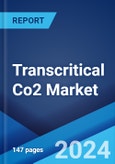The global transcritical CO2 market size reached US$ 44.7 Billion in 2022. Looking forward, the publisher expects the market to reach US$ 117.1 Billion by 2028, exhibiting a growth rate (CAGR) of 16.7% during 2023-2028.
Transcritical CO2 refers to a refrigeration system comprising a gas cooler to dissipate heat and a high-pressure expansion valve to control the evaporator. It is environmental-friendly, non-flammable, non-toxic, and has good heat transfer properties with a high latent heat of vaporization. It is cost-effective due to the utilization of cheaper fluids and higher efficiency compared to conventional refrigeration systems. In addition, it helps recover the rejected heat on account of the higher enthalpy of the system that can be used for building heating, ventilation, and air conditioning (HVAC) and domestic hot water. As a result, transcritical CO2 finds extensive applications in the food and beverage (F&B) and retail industries across the globe.
Transcritical CO2 refers to a refrigeration system comprising a gas cooler to dissipate heat and a high-pressure expansion valve to control the evaporator. It is environmental-friendly, non-flammable, non-toxic, and has good heat transfer properties with a high latent heat of vaporization. It is cost-effective due to the utilization of cheaper fluids and higher efficiency compared to conventional refrigeration systems. In addition, it helps recover the rejected heat on account of the higher enthalpy of the system that can be used for building heating, ventilation, and air conditioning (HVAC) and domestic hot water. As a result, transcritical CO2 finds extensive applications in the food and beverage (F&B) and retail industries across the globe.
Transcritical CO2 Market Trends:
There is currently a rise in the demand for air conditioning units in the hospitality and residential sectors around the world. This, along with the lower operational costs of transcritical CO2 systems, represents one of the key factors driving the market. Moreover, high maintenance costs of hydro-chlorofluorocarbon (HCFC) and chlorofluorocarbon (CFC) based equipment is propelling the growth of the market. In addition, there is an increase in the utilization of transcritical CO2 systems due to the rising awareness among individuals about global warming. This, coupled with the growing demand for CO2 as an alternative on account of its high energy performance and the same technical reliability as HFC-134a refrigerant, is positively influencing the market. Besides this, the escalating demand for transcritical CO2 in cold storage facilities is offering lucrative growth opportunities to industry investors. Apart from this, governments of several countries are implementing stringent regulations to reduce the use of fluorinated gases (F-gases), which, in turn, is impelling the market growth.Key Market Segmentation:
The publisher provides an analysis of the key trends in each sub-segment of the global transcritical CO2 market report, along with forecasts at the global, regional and country level from 2023-2028. The report has categorized the market based on function and application.Breakup by Function:
- Refrigeration
- Heating
- Air Conditioning
Breakup by Application:
- Supermarkets and Convenience Stores
- Ice Skating Rinks
- Food Processing and Storage Facilities
- Heat Pumps
- Others
Breakup by Region:
- North America
- United States
- Canada
- Asia-Pacific
- China
- Japan
- India
- South Korea
- Australia
- Indonesia
- Others
- Europe
- Germany
- France
- United Kingdom
- Italy
- Spain
- Russia
- Others
- Latin America
- Brazil
- Mexico
- Others
- Middle East and Africa
Competitive Landscape:
The competitive landscape of the industry has also been examined along with the profiles of the key players being Baltimore Aircoil Company Inc. (AMSTED Industries Incorporated), Bitzer SE, Carnot Refrigeration (M&M Refrigeration), Carrier Global Corporation, Danfoss, Dorin S.p.A., Emerson Electric Co., Hill Phoenix Inc. (Dover Corporation), Mayekawa Mfg. Co. Ltd., Panasonic Holdings Corporation and SCM Frigo S.p.A.Key Questions Answered in This Report:
- How has the global transcritical CO2 market performed so far and how will it perform in the coming years?
- What has been the impact of COVID-19 on the global transcritical CO2 market?
- What are the key regional markets?
- What is the breakup of the market based on the function?
- What is the breakup of the market based on the application?
- What are the various stages in the value chain of the industry?
- What are the key driving factors and challenges in the industry?
- What is the structure of the global transcritical CO2 market and who are the key players?
- What is the degree of competition in the industry?
Table of Contents
1 Preface3 Executive Summary10 Value Chain Analysis12 Price Analysis
2 Scope and Methodology
4 Introduction
5 Global Transcritical CO2 Market
6 Market Breakup by Function
7 Market Breakup by Application
8 Market Breakup by Region
9 SWOT Analysis
11 Porters Five Forces Analysis
13 Competitive Landscape
Companies Mentioned
- Baltimore Aircoil Company Inc. (AMSTED Industries Incorporated)
- Bitzer SE
- Carnot Refrigeration (M&M Refrigeration)
- Carrier Global Corporation
- Danfoss
- Dorin S.p.A.
- Emerson Electric Co.
- Hill Phoenix Inc. (Dover Corporation)
- Mayekawa Mfg. Co. Ltd.
- Panasonic Holdings Corporation
- SCM Frigo S.p.A.
Methodology

LOADING...
Table Information
| Report Attribute | Details |
|---|---|
| No. of Pages | 142 |
| Published | September 2023 |
| Forecast Period | 2022 - 2028 |
| Estimated Market Value ( USD | $ 44.7 Billion |
| Forecasted Market Value ( USD | $ 117.1 Billion |
| Compound Annual Growth Rate | 17.4% |
| Regions Covered | Global |
| No. of Companies Mentioned | 11 |









